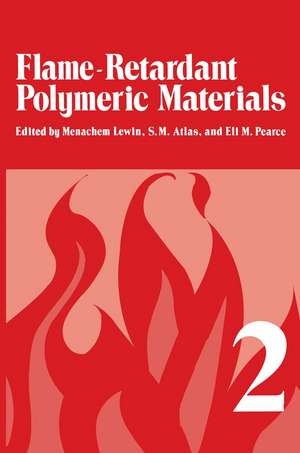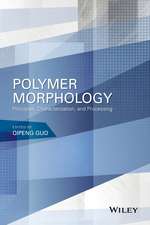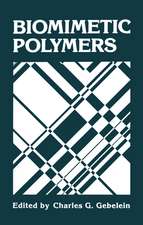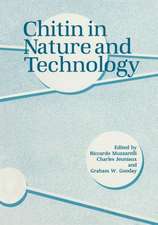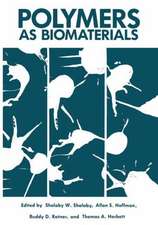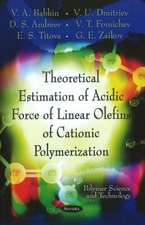Flame-Retardant Polymeric Materials: Volume 2
Editat de Menachem Lewinen Limba Engleză Paperback – 22 mar 2012
Preț: 390.25 lei
Nou
Puncte Express: 585
Preț estimativ în valută:
74.68€ • 78.16$ • 62.15£
74.68€ • 78.16$ • 62.15£
Carte tipărită la comandă
Livrare economică 31 martie-14 aprilie
Preluare comenzi: 021 569.72.76
Specificații
ISBN-13: 9781468469752
ISBN-10: 1468469754
Pagini: 348
Ilustrații: XII, 334 p. 20 illus.
Dimensiuni: 152 x 229 x 18 mm
Greutate: 0.47 kg
Ediția:Softcover reprint of the original 1st ed. 1978
Editura: Springer Us
Colecția Springer
Locul publicării:New York, NY, United States
ISBN-10: 1468469754
Pagini: 348
Ilustrații: XII, 334 p. 20 illus.
Dimensiuni: 152 x 229 x 18 mm
Greutate: 0.47 kg
Ediția:Softcover reprint of the original 1st ed. 1978
Editura: Springer Us
Colecția Springer
Locul publicării:New York, NY, United States
Public țintă
ResearchCuprins
1 Structure, Pyrolysis, and Flammability of Cellulose.- 1. Introduction.- 2. The Fine Structure of Cellulose.- 3. The Major Products of Cellulose Pyrolysis: Levoglucosan and Char.- 4. Vacuum Pyrolysis.- 5. Air Pyrolysis.- 6. Flame Retardancy.- 7. References.- 2 Synergism and Flame Retardancy.- 1. Introduction.- 2. Synergism.- 3. Synergistic Reactions in Fire Retardation.- 4. Synergism and Future Studies on Fire Retardation.- 5. References.- 3 Ignition of Polymers.- 1. Introduction.- 2. Autoignition Studies.- 3. Autoignition of Multicomponent Systems.- 4. The State of the Art.- 5. References.- 4 Phosphorus-Based Flame Retardants.- 1. Introduction.- 2. Inorganic Phosphorus Compounds.- 3. Organic Phosphorus Flame Retardants—Additive Types.- 4. Organic Phosphorus Compounds—Reactive Types.- 5. Mode of Action of Phosphorus Flame Retardants.- 6. Trends and Future Developments.- 7. References.- 5 Flammability of Cotton-Polyester Blend Fabrics.- 1. Theory of Flame-Retardant Action.- 2. Flame-Retardant Treatments for Polyester-Cotton Blends.- 3. References.- 6 Factors Affecting the Combustion of Polystyrene and Styrene.- 1. Introduction.- 2. Physical and Thermal Properties of Polystyrene and Styrene.- 3. The Pyrolysis and Combustion of Polystyrene and Styrene.- 4. The Mechanisms of Flame Retardation.- 5. The Effects of Halogen Flame Retardants on the Combustion of Polystyrene and Styrene.- 6. The Role of Synergists in the Combustion of Styrenic Materials Inhibited by Halogen Compounds.- 7. The Use of Phosphorus Compounds as Flame Retardants for Polystyrene.- 8. Test Methods and Their Usefulness to Combustion Studies.- 9. Conclusions.- 10. References.- 7 Phenolic Fibers.- 1. Introduction.- 2. Preparation of Phenolic Fibers.- 3. Properties of Phenolic Fibers.- 4. Thermal andChemical Resistance.- 5. Uses.- 6. References.- 8 Flame-Resistant Wool and Wool Blends.- 1. Introduction.- 2. Wool.- 3. Research Strategies for Flame-Resistant Wool.- 4. Flammability Test Methods.- 5. Inorganic Compounds.- 6. Organic Compounds.- 7. Mechanisms of Flame Retardation.- 8. Safety of Flame-Resistant Fabrics.- 9. References.- 9 Smoke and Tenability: A Perspective on the Materials Approach to the Fire Problem.- 1. Introduction: Combustion versus Fire.- 2. Fire: Ignition and Materials.- 3. Smoke: A Hazard Analysis.- 4. Smoke: The Measurement Problem.- 5. Correlation: Studies of Small- and Large-Scale Smoke Tests.- 6. Smoke Hazard Control: The Fire Detector Aspect.- 7. Smoke Hazard: The Materials Perspective.- 8. Smoke Hazard Assessment: Summary.- 9. References.
